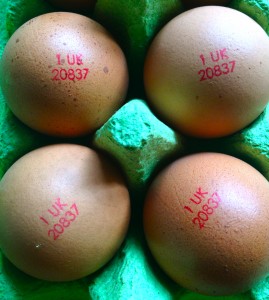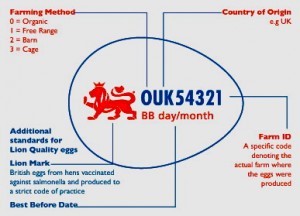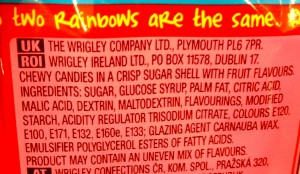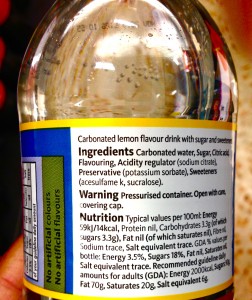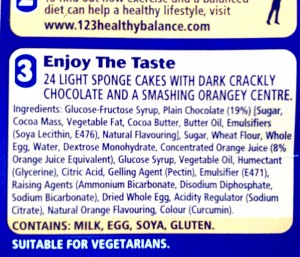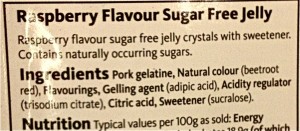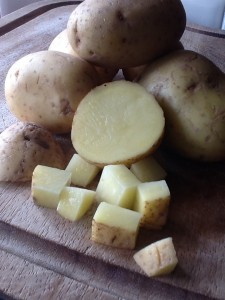Eggs…part 1: good or bad…?
Additives…food colour…
Food colouring E – numbers from 100-199
Colours are added to foods to make them look more appealing or more like the colour that consumers associate with that food. ‘We taste with our eyes’ it is said to describe the results of tests that conclude consumers believed something tastes better if it is the expected colour. They are also used to replace the natural colour lost during food processing or storage, to enhance the natural colour or to make products a consistent colour. They are even used to give colour to an item that might otherwise be colourless like the Skittles above. Some groups argue that adding colour is unnecessary and misleading as well as raising concerns over their safety.
The EU laws currently allow 45 colours and also control what foods they are used in and maximum amounts allowed – extremely small amounts in most cases. The EFSA (European Food Safety Authority) tests for safety (and re-evaluates these results) and issues ADI’s (Acceptable Daily Intakes) for each substance, calculating and allowing for a lifetime’s consumption (this includes the usual safety factor margin of 100 for all E numbers).
Colours commonly used:
- Curcumin (E100), a yellow colour extracted from turmeric roots.
- Plain caramel (E150a), which is used in products such as gravy and soft drinks
- Riboflavin (vitamin B2 – E101)
- Beta-carotene (E160a)
- Amaranth (E123)
Colourings for food are either synthetic, created from natural sources or ‘nature identical’. Natural food colourings come from plant sources such as fruit skins, vegetables, grasses and roots. The red colourant carminic acid (E120/cochineal) comes from the dried and crushed bodies of a type of insect.
Manufacturers often prefer synthetic colours as they are stable and consistent, usually brighter than the original, and mostly cheaper to make. It also means a colour, like the above-mentioned carminic acid, can be recreated without the inclusion of the insects! An added advantage is that the synthetic colours need no further processing to be added to foods as they are water soluble as opposed to the oil soluble natural and nature identical colours which need a further processing stage to be useable.
However some colours, especially those called the ‘azo dyes’ are associated by some pressure groups to behavioural problems in children (especially ADHD) and others with skin problems and certain cancers. The UK Food Standards Agency requires a mandatory warning of the presence of six artificial colours (that combined with the preservative sodium benzoate have been linked to increased hyper activity in children), passed a voluntary ban(!) and publish a list of brands that produce items without these colours.
EFSA reduced the ADI of these three of the six most contentious colours too:
- Sunset yellow – E110 – typically found in orange flavoured drinks and cordials, apricot jam, marmalade and packet soups.
- Ponceau 4R – E124 – (banned in the US as a result of its link with cancers). Used in dessert toppings, jellies, trifles, soups and salami.
- Quinoline Yellow – E104 – used to dye smoked haddock (an alarming yellow colour!) and egg products like scotch eggs. But more typically found in lipsticks and some medications
However, it did not reduce these three:
- Carmoisine – E122 – used in jams, yoghurts and jellies.
- Tartrazine – E102 which is the colour most strongly linked to hyperactivity in kids. Tartrazine is actually a yellow dye and can be found in a lot of yellow coloured foods (such as ice cream) and is the base for the creation of many other colours (used as a primary yellow).
- Allura red – E129, typically found in sweets, soft drinks but also in medicines.
However, the research and studies conducted have proved to be inconclusive regarding any links to problems caused by these colours at the amounts allowed…
Regardless, as with any of these additive issues, if you are concerned about the potential harmful effects then it’s best to avoid all foods containing any contentious additives…makes sense, right?
Additives…sweeteners…
Sweeteners
Sweeteners were developed to replace sugar after sugar was discovered to be the cause of tooth decay and linked to obesity related diseases. The idea behind them is essentially to provide the sweetness but not the same energy intake and still give the sweet aspect to taste that many people are used to, and perhaps even addicted to. Sweeteners cannot completely replace sugar as the sugar element in some processed foods, like cakes, also performs other functions such as retaining humidity (humectant) and provides bulk and structure to the finished product.
Typical products that use sweeteners heavily are:
- Sodas, alcoholic and non-alcoholic drinks etc.
- Sweets/candy – chewing gum and mints are reliant on sweeteners
- Desserts, ice creams etc.
- Many baked goods and processed foods both sweet and savoury, including dressings, sauces and bread
- Breakfast cereals
- Many medicines
Commonly used sweeteners are:
(they are gauged for their sweeteness against sucrose – the chief compound in cane and beet sugars aka table sugar…yeah the white stuff that you all know I hate…!)
‘Intense’:
- Aspartame (E951) – sweetness value 200 times higher than sucrose.
- Aspartame-K (E950) – a synthetic compound that mixes well with other sweeteners to create either more complex taste or greater levels of sweetness. It has a sweetness value 300 times higher than sucrose.
- Saccharin (E954) – a synthetic compound that is rarely used alone now and 300 times sweeter than sucrose.
- Sucralose (E955) – the ‘strongest’ of sweeteners with sweetness value of 600 times that of sucrose.
‘Bulk’:
- Sorbitol (E420) – carbohydrate like structure but only just over half as sweet as sucrose. A preferred sweetener for diabetic purposes.
- Xylitol (E967) – created to match the sugar sweetness of sucrose so it is much sweeter than sorbitol. Used in similar quantities therefore to sugar and sold in shops in bags to use as such. It is a naturally occurring substance in many plants and suitable for diabetics and even heralded as an active anti-cavity aid as it prohibits the growth of bacteria (it’s chemical composition means bacteria and yeasts cannot make use of it to ‘feed’ themselves).
‘Artificial’ or ‘intense’ sweeteners like aspartame, saccharin, and acesulfame-K are many, many times sweeter than sugar and are only needed subsequently in very small amounts. Increasingly these are used in combinations to create ‘superior taste profiles’ which mirror the complexities of the natural taste of sugar and require fewer sweeteners over all. The defense of their use therefore notes that this not only creates tooth-friendly foods but also reduces calories significantly due to the minute amounts used. (Those against them argue this ‘taste profiling’ also makes them more addictive.)
‘Bulk’ sweeteners like sorbitol (used as a combination humectant, sweetener and emulsifier), xylitol and maltitol (E965 – used as a combination sweetener, humectant and stabilizer) can have from 35% – 100% similar sweetness to sugar and so they are used in similar amounts to sugar. They are also tooth-friendly and are considered suitable (or at least more suitable) for diabetics as they have a significantly reduced glycemic index, although they have laxative properties if consumed in large amounts resulting in mandatory warnings on product packaging.
Sweeteners also became popular as part of weight loss programs. Sugar began to be replaced with non-calorific or reduced calorie sweeteners in many popular items (this was also a boon for diabetics (especially sorbitol) as mentioned above). Don’t be fooled by this though! I’ll be posting more thoroughly about this soon but research the arguments against sugar and the role sweeteners play in weight gain…it’s very interesting and it will surprise you! Here’s a taster…
The opposition to sweeteners is strong with pressure groups claiming no good and proper evidence exists to prove that sweeteners do anything whatsoever to help weight loss, specifically. In fact, they say the evidence is strongly available to show the opposite. In essence, the theory is that sweeteners cannot trigger the ‘reward centre’ in the brain in the same way as sugar and then the brain triggers further appetite stimulation to intake the calories (especially carbohydrates) that the sweeteners have created a desire for (in the mouth). Similarly some anti-sweetener groups say that the brain triggers insulin release just based on the expectation that the sweetener creates in the mouth, regardless of the reward centre, potentially causing insulin spikes etc. and all this means more sugars in the body that are not used and subsequently turned to stored fat. Beware…!
Some sweeteners have been linked to cancers in lab animal testing research further raising concerns over their safety especially cumulatively when eaten many times in many products throughout a day. Other noted issues are sleep and anxiety disorders, triggering epilepsy and interference with the progress and efficaciousness of medications – especially anti-depressants (sweeteners are often in medicines too). I’d say the evidence stacked against sweeteners (especially aspartame, aceslulfame-k, saccharin and sucralose) and their effects on fundamental body systems and functions are enough to avoid then until a convincing and conclusive study proves otherwise!
Additives…emulsifiers, gelling agents, thickeners, stabilisers…
Emulsifiers are the chemicals needed to create an emulsion. Therefore an emulsifier is an additive that keeps two substances, which would usually naturally separate from each other, mixed. In food this is usually oil and water. There are oil-in-water or water-in-oil versions used*. They are used in many food products and are vital for the texture, ‘conditioning’, stability, even taste and indeed structure of the product, many of which would look very unappealing and/or be more vulnerable to spoiling without the emulsifier. Products like bread would be uneven (large holes would be visible) have less size and a drier texture without emulsifiers. Ice cream, margarine and mayonnaise are other foods that are completely reliant on emulsifiers for their structure and texture.
*The science bit : Due to emulsifiers having two distinct parts to themselves, one that likes to be in oil and one that likes to be in water, when they are added to either version (oil-in-water or water-in-oil) they will coat the appropriate element and keep it from clumping together and consequently separating into their own layer within the product. So, in essence, in water-in-oil emulsions the emulsifier coats the water molecules to prevent them separating from the oil and vice versa in oil-in-water emulsions.
Nature has many perfect emulsions such as the usually quoted example of milk, where the fat molecules are perfectly suspended in the surrounding aqueous solution. These are usually some form of protein or phospholipids (enables oil-in-water emulsion – e.g. lecithin)
Commonly used emulsifiers are either purified natural versions or synthetic versions that are ‘copies’ of the natural and have very similar structures. The most usual are:
- Lecithin (E322)
- Mono/di glycerides of fatty acids (E471)
- Esters of monoglycerides of fatty acids (E472a-f)
Similarly to the emulsifiers these are used to create shape and texture and therefore make the food look and ‘feel’ good. Thickening and stabilizing additives work with the emulsifiers to do this, especially products that would be runny and/or unappealing without them, or would deteriorate during processing, transportation or cooking. The longevity and regularity of the structure of processed foods relies on these additives and indeed marks the key difference between what we make for ourselves, without these additives, and the foods we buy fully expecting long shelf-life, the ability to freeze and store etc.
Without gelling agents many jams, jellies etc. would never set and remain stable (pectin added), fruit pie fillings would become runny and soak through the pastry long before reaching a consumer, and their use in soya protein products ensures that the soya product remains in tact even at high cooking temperatures.
Gelatine provided a key way to gel and set foodstuffs for many years but the animal source means that nowadays more often all-dietary issue inclusive alternative options are used, such as carrageenan. Gelatine is made by boiling animal carcasses (all bones and tissue) and the collagen turns to gelatin that can then be used as a powder or in sheets. Its effectiveness is also reduced by the presence of acid so pectin works better with high fruit content items such as jam.
The most commonly used are:
- Gum arabic (E414) from plant secretions (sap of the acacia tree)
- Guar gum (E412) extracted from guar beans
- Locust bean gum (E410) from the endosperm of seeds of the carob tree
- Xanthan gum (E415) from fermenting glucose or sugar
- Agars (406) extracted from specific red algae
- Carrageenan (E407) extracted from several types of, usually farmed, red seaweed (as used in the jelly crystals element of the trifle mix above*)
- Pectin (E440) extracted from fruit such as citrus peel or remainder pulp from pressed apples (as used in the Jaffa Cakes above)
- Starch (E1401-1451) isolated from many different sources such as potatoes, corn, wheat and cassava and from chemical modifications
- Carboxymethyl cellulose (466) made through a process of reacting cellulose with acids (a very common thickener as used in the jelly crystals and topping in the trifle mix above)
*The jelly crystals element of the trifle mix (shown above) also uses two chemicals disodium phosphate (a multi functional additive which can be used as an acidity regulator, stabilizer, emulsifier and/or to prevent coagulation) and potassium chloride (usually used as a salt substitute and/or and flavour enhancer).
Specific thickening agents added (whether gelling agents and/or stabilisers) are also used to provide bulk and fibre as their gum like properties are tasteless, odourless and have practically no calorific content.
Additives…antioxidants…
Antioxidants E – numbers from 300-399
When foods are exposed to oxygen they begin to break down and decay (oxidation) and this causes discolouration, rancidity and can change/destroy the nutritional value of the item (e.g. they are used to prevent vitamins combining with the air and being destroyed). Antioxidant additives are used to stop or delay these processes. Foods made using fats or oils are likely to contain antioxidants too even if they are low in fat, as they help prevent decomposition especially when unsaturated fats are involved. The decomposing fat reacts with the oxygen creating the release of peroxides which we know by that characteristic rancid fat smell. Grim…
Many processed and prepackaged products contain an antioxidant; a majority contains citric acid (although vitamin C** (ascorbic acid/E300) is one of the most widely used). Citric acid (which occurs naturally in fruits such as lemons) is used extensively to prevent discolouration, help increase the antioxidant effects of other substances and, in some cases, help regulate the PH balance (marmalade, jellies etc). Ascorbic acid is used to prevent discolouration but largely to replace vitamin C**, or add it back in to, any products where it might have been lost in processing or needed for an extra vitamin boost to the product (fruit juices etc. especially orange juice).
**However, this is contentious (isn’t everything?!) as many noted experts have pointed out that added elements such as ascorbic acid, retinoic acid and types of tocopherol (…er…sorry getting carried away (showing off more like?!?) I mean, added elements labelled as vitamin C, vitamin A or vitamin E) are not the actual vitamin at all but just a lab created isolation of them (synthetic versions needed to replace the naturally occurring versions lost during processing – especially vitamin C which is destroyed by heat). The essential theory being that vitamins are complex compounds that need to work within a set of multi level parameters and so creating an individual molecular compound from them might well work as a preservative, antioxidants etc. but does not therefore consequently also work within the body as a fully fledged vitamin. I.e. you’re getting the vitamin just not any benefit. The American company ‘Real C’ use the analogy: ‘If you compare Vitamin C to an egg, ascorbic acid would be just the egg shell with nothing inside’. Hmmm…
There are only a few available to producers in the EU and the most popular/frequently used in processed foods are:
- Ascorbic acid (vitamin C/E300)
- Citric acid (E330)
- BHA (butylated hydroxyanisole/E320)
- Tocopherols (vitamin E group/E306-309)
BHA and BHT are considered safe in the small doses used by the food industry (for the protection of fats and oils in foods) as they perform better at high temperatures than their natural equivalent vitamin E, but they remain contentious to pressure groups.
Synthetic and natural versions are often used in combination as this can increase their effectiveness. The arguments for the inclusion of antioxidants extend past their usefulness for food preservation etc., but to their reported use in the body for fighting free radicals. These ‘unpaired’ electrons are a danger as they ‘attack’ other molecules to gain a pairing. Antioxidants, vitamin C and vitamin E especially, stabilize these electrons by ‘donating’ one of theirs and as they are stable in either state (paired or unpaired) they do not become a free radical themselves. Increasingly, however, the results from major clinical trials are claiming that too many antioxidants in the body can be dangerous. A good intake is found in balanced, varied diets with fruit and vegetables, but the imbalance forms when the ‘added’ antioxidants are also factored in from processed and fortified foods. Some of these research reports are arguing that some antioxidants do indeed become, at least temporarily, radicals as they are only neuralised by another member of the antioxidant team. Again, this supports the need for a balanced diet of varied antioxidants to ensure there is no imbalance in the levels of a particular antioxidant, which might leave the body vulnerable without enough other antioxidants to restore the balance. Think on…
MAP or EMAP (Modified Atmospheric Packaging or Equilibrium Modified Atmospheric Packaging) are further examples of antioxidant additives at work. The process essentially replaces the oxygen within the sealed packaging (meats, seafood, crisps, salad bags etc.) with higher levels of CO2 (anti-bacterial and anti fungal) and Nitrogen (inert gas used as a filler) and used extensively to prevent further ripening or spoilage and discolouring.
Additives…preservatives…
Preservatives – E numbers 200-299
Various ways to make food last longer have been employed throughout history. Unless another method of preserving the food has been used, like freezing or canning, then any food that has a clearly prolonged shelf life is likely to include preservatives. More traditional preservatives such as sugar, salt and vinegar are still used to preserve some foods but just as likely is some kind of added (probably synthetic) preservative. Most are added to prevent the growth of molds and yeasts but they have some anti-bacterial properties too.
Microbes are everywhere. They are in the air, in the earth, inside our bodies and in the food we eat. Microbes will multiply in the right atmosphere by their millions, and in a really short time, so the certain ones that break down foods are the ones the preservatives are attempting to stop or at least slowing them down. Different microbes react to different preservatives so there are many used in many everyday products and foods. Without them the food would not only deteriorate quickly it would also subsequently allow bacteria that cause deadly illnesses like botulism and salmonella poisoning to spread (especially in animal products).
A common example is that dried fruit (drying is a form of preserving in itself) is often treated with sulphur dioxide (E220) to stop further deterioration. One very important use of preservatives from a food safety angle is its use in processed meats such as ham, bacon, salami and sausages. They are usually treated with nitrite and nitrate during the curing process as bacteria in the meats can cause fatal food poisoning. It is often argued as an example of the benefit of preservatives, in fact, that the tiny ‘safe’ amount of the preservative used far outweighs the potential damage from the deadly bacteria’s they negate.
Many advantages are gained from adding preservatives and generally preserving food. It not only keeps food safer for longer from deterioration or poisonous bacteria, but this allows for increased availability of out of season produce or items that are not native to be transported. Convenience for the consumer is another added value (although can mean the price of the goods is higher) and not only does this mean less wastage but also prevents the need for regular shopping, which is an advantage to many.
Most popular/frequently used in processed foods:
Benzoate preservatives:
- benzoic acid (E210)
- sodium benzoate (E211)
- potassium benzoate (E212)
- calcium benzoate (E213)
Sulfite preservatives (E220 – E224)
Nisin (E234)
Propionic acid (E280)
Nitrite preservatives:
- sodium nitrite (E250)
- potassium nitrite (E249)
Sorbic acid (E200)
Potassium sorbate (E202) – a synthetic preservative used for its antibacterial and anti-fungal properties.
There has been a lot of contention over the use of preservatives in food and there are a number of them in frequent use that have been targeted as not particularly good for us. They are regulated and maximum levels are set to well below amounts that could be deemed at all dangerous. Concern is largely over the accumulation of these ‘tiny, harmless amounts’ over time could increase the risk of cancer. Also, sugar and salt, whether added for flavour or to assist the preservative nature of processed foods, are also under fire. Their over bearing presence in processed food is a mainstay of the argument against it. I’ve discussed the horrors of sugar at length previously, here. And discussed salt here.
Common preservatives that are listed as those to avoid are nitrates (Potassium nitrite and sodium nitrite (E249 and E250) – preserve colour and help fight bacteria – stabilising and flavouring too AND nitrItes are considered worse than nitrAtes), sulphites (prevents discolouration), sodium benzoate (preserves against fermentation or acidification), BHA/BHT (preserves fats and oils – as an antioxidant) however without these there is no longevity to foods and there might be many more cases of food poisoning.
These preservatives are also argued to be safe (not only by the regulators and manufacturers but by some health officials too) and in some cases the preservative is actually promoted as beneficial. These are commonly used and include ascorbic acid (vitamin C)**, critic acid (and to enhance sour flavours) and sorbates (fight bacteria and yeast).
**However, this is contentious (isn’t everything?!) as many noted experts have pointed out that added elements such as ascorbic acid, retinoic acid and types of tocopherol (…er…sorry getting carried away (showing off more like?!?) I mean, added elements labelled as vitamin C, vitamin A or vitamin E) are not the actual vitamin at all but just a lab created isolation of them (synthetic versions needed to replace the naturally occurring versions lost during processing – especially vitamin C which is destroyed by heat). The essential theory being that vitamins are complex compounds that need to work within a set of multi level parameters and so creating an individual molecular compound from them might well work as a preservative, antioxidants etc. but does not therefore consequently also work within the body as a fully fledged vitamin. I.e. you’re getting the vitamin just not any benefit. The American company ‘Real C’ use the analogy: ‘If you compare Vitamin C to an egg, ascorbic acid would be just the egg shell with nothing inside’.
Hmmm…
So, while it is more than likely ‘urban legend’ that bodies are not decomposing in the ground due to the large amount of preservatives eaten in a lifetime (although some sources are adamant it is true and it’s possible that they are adversely affecting the bacteria that usually break down the body after death) it is safe to say that they’re not exactly good for you. The body is still required to break down the chemical and foreign compounds and it would really rather not have to do it too often…and research shows the digestive system struggles to extract any nutritional value from highly preserved foods.
An initial thought about bread…
I was given this interesting juxtaposition in response to a post about synthetic versus natural ingredients in skin care products. It’s thought provoking I should say…!
“Synthetic, by the way, is interestingly defined as ‘made by chemical synthesis especially to imitate a natural product.’”
That would actually be a ‘nature identical’ product. The majority of synthetic ingredients don’t exist in nature to start with, and those that do, and claim to be synthetic copies, are molecularly so different, they couldn’t possibly be considered the same and the body doesn’t recognise them as such.
That is not to say that un-natural products are inherently wrong. Let’s take an example of food: bread.
Putting to one side for a moment the carb bashers, bread is considered a basic (natural) food.
Yet bread doesn’t grow on trees. It doesn’t exist in nature. Like a beauty cream it is a concoction of ingredients that undergo chemical reactions (yeast), mechanical action (kneading) and heat reactions (baking) to produce a food that could never exist in nature even if they were lying side by side in the sun during an earthquake!
We (excluding the carb bashers) believe bread to be a nourishing healthy food. If made in the traditional way with fermented grains, milks, yeasts, leavened over a day or so… YUM!
But what about the way it is made today? Filled with Mono & Di-glycerides, Sodium Stearoyl Lactylate (SSL), and Diacetyl Esters of Tartaric Acid (DATEM), Lecithin from GM soy (yes, GMs may be banned here but so is horse meat), Azodicarbonamide (mainly used in production of foamed plastics as an additive and recently identified as a respiratory sensitiser), Calcium propionate, Hydrochloride and Sodium metabisulphate, Ammonium sulphate, Monocalcium phosphate or calcium carbonate… all ingredients used to ‘imitate’ fresh bread that has been made by hand in a time honoured manner, and can last weeks on end in order to extend shelf life. And some of those ingredients won’t even be labeled as such but instead are called whey extract and so on.
Oh, and if you’re older than 23, you’ve also been eating Bromide, only banned in the UK in 1990 as an endocrine disruptor.
And that’s just bread. The original, albeit un-natural food, is a delicious, probiotic concoction to be smothered in butter and jam. Nothing wrong with an un-natural product. But when you start messing with it, adding synthetic chemicals, emulsifiers and preservatives to benefit the mass manufacturers and supermarkets… well, it’s hardly bread anymore.
And if that’s what they allow to happen to our food, an essential resource, why on earth would there be concern over our vanity products?
Hmmm…
Good point…
(Thanks Sarah)
So, it made me think I should re-activate the Quatermass looking yeast starter I have lurking sulkily in the back of my fridge and make some ‘proper’ bread! So watch this space…
oh…and just to freak you out even more about bread…(especially number 2)
Stopping smoking…
I, like many people in my generation, grew up with the fug of adults smoking. I don’t remember hating it at the time but I certainly don’t remember loving it either. I remember brown teeth and stale breath, the grainy dankness of the rooms the following day. Anyone who has gone into a pub in the first light of day will completely relate.
Yes I hear people say ‘well, my Uncle Cyril lived till he was a thousand and he smoked sixty a day…’. Yes, but it’s not as easy to cling to false hope when you hear the stories from the sadly more than equal amount of people who have a completely different experience of their loved ones.
When I am taking people through my nutrition programme it is the first thing that I ask about. Smoking simply doesn’t give you a fighting chance to be healthy or fight the ageing process. Fact. So, although I completely subscribe to the right of people to live their lives as they see fit I have to always recommend the stopping of smoking.
Health reasons are the top of most people’s list of why they quit. It should be. Smoking harms nearly every organ of the body. Half of all smokers who keep smoking will end up dying from a smoking-related illness. Lung cancer is the most known but mouth, nose, throat, kidney, stomach etc have all been connected to smoking too, along with leukaemia, emphysema and chronic bronchitis. These latter two making your breathing difficult and increasing over time until they are fatal. But the list certainly doesn’t end there. There is the very real likelihood of heart attack. Smokers are twice as likely to die of a heart attack than non-smokers and smoking weakens and narrows the blood vessels to the brain and limbs adding stroke to the increased potential risks.
Enough to convince you? No? Well, there’s the increased risk of macular degeneration and cataracts and do you really want to live with the gum disease and tooth loss or the bad breath and stinky hair and clothes, premature wrinkles, or the yellow teeth and fingernails?!?
Okay, you may dismiss the latter as vanity but primarily smoking will kill you. It strikes me that the current way of things in the world is putting the body under attack from so many sides and as no one truly knows how the complexities of the foods and nutrients we eat react with the complexities of the body, why interrupt and damage that fragile system any more than necessary? Processed foods, sugar, additives and lab created chemicals replacing organic processes are elements already triggering dangerous reactions in our bodies and so it’s mad to add smoking to the mix, especially as smoking is a known killer.
Plus, did I mention it ages you?!? So if you want to look like yoda when you are a hundredth of his age…
Women have some extra risks linked to smoking. Women over 35 who smoke and use birth control pills have a higher risk of heart attack, stroke, and blood clots in the legs. Women who smoke are more likely to miscarry or have a lower birth-weight baby. Low birth-weight babies are more likely to die or have learning and physical problems. It’s a serious business…
I can also understand that you might be thinking why stop now? Often there is an inertia to quitting that comes from a denial and a belief that the damage is done, perhaps, or that you’ve come this far…but no matter how old you are you will benefit from stopping smoking with a greater quality of health and life. Weight gain that is feared after quitting is of much less risk than smoking that’s for certain fact.
So the big question is: How to stop?
There doesn’t seem to be a definitive one right way to stop, but there are four stages of the process to consider :
- Making the decision to stop
- Choose a date to stop and a plan of action
- Coping with the withdrawal
- Remaining a non-smoker
Making the decision to stop has to come from you. Sounds obvious but a directive led by a friend who wants to stop and is getting you to ‘have a go’ too will lack commitment or focus from you. You yourself must be ready to stop and ready to make a serious commitment.
Selecting a date to stop is a time honoured way to begin, choosing a date not too far in the future so you don’t have time to talk yourself out of it and stand by the commitment. If you are using a prescription drug to assist you then this needs to be factored in so take advice from the health care professional you are consulting.
Another preferred action is to stop cold turkey and with no assistance from nicotine replacement products. Not necessarily recommended by experts as it is a tough road to take but for some it is the only way to tackle it psychologically as the idea of slowly reducing the cigarettes smoked to reduce withdrawal symptoms etc can be equally hard to stick to and much easier to dismiss along the way. But sadly the cold hard truth is there is no miracle way to achieve the breaking of the addiction. It’s like weight loss in that it requires a lifestyle and mental attitude change and a life long commitment to be successful. Just in the way a bolted on diet will NEVER work, attempting some half thought through, half hearted stopping smoking plan will NEVER work either.
Plan the event of stopping properly. If you’re going to use replacement to roducts, prescription drugs or join support groups, get all that arranged before hand. Ask for support from friends and family that are still smoking to not do so around you and to keep temptation from your sight! Chuck out all the cigarettes, ashtrays etc from all areas of your life – home and work.
So, the day of reckoning arrives and you are stopping. First of all, well done by the way! You should always praise yourself for every tiny step of the way. This initial period is the toughest and you should be proud of your achievements accordingly. On the day you stop smoking, literally stop. Completely. Not even a whiff of smoke and certainly not the odd puff! Avoid people who are smoking and situations where you would ordinarily have smoked. This may well mean changing your routine and avoiding things like coffee and alcohol that you associate with a cigarette. Exercise and drink lots of water to help your body cope with the withdrawal.
If you feel an urge to light up, wait. Tell yourself to wait ten or fifteen minutes for the urge to pass. Baby steps…
Nicotine replacement products will help you with the physical withdrawal but those symptoms pass soon enough. Other oral fixations are needed to replace the smoking one – that sounds ruder than I intended but I think you know what I mean! Try to avoid too many sweets or gum as these have the equally poisonous sugar in them but that’s a different soapbox elsewhere on this site! Chew on vegetables, seeds and fruit instead or get up and go for a walk, breathe deeply and fight the drug withdrawal with everything you’ve got.
The mental withdrawal is tougher for many as smoking is linked to so many aspects of daily life. You may find that even when using nicotine replacement products you still have the urge to smoke. This psychological impulse is hard to fight. Recognise it for what it is and attempt to disassociate yourself from it – realise it is a ‘rationalisation’. These thoughts are sneaky ways the old smoking you tries to fool you into doing something that will undo your hard work and make you smoke again. Thoughts like:
- you have to die of something and how bad is smoking really?
- I’ll just have the one to get me through this rough spot
- I like it and it is my only vice!
- The air pollution is probably worse actually…
- I won’t stop today actually because it’s so and so’s party on Friday…so next week is better…
Remaining a non-smoker is the challenge. Remembering why you stopped and focussing on the benefits you feel will help and when the urge comes just sit it out for a while first and use the techniques you used then you were stopping in the first place. Those sneaky rationalisations can strike at any time and can be many months after you’ve stopped. Be aware!
Many worry about weight gain but eating a varied, balanced diet and doing a modicum of exercise will take care of that…which goes for everyone in truth.
If you do slip and smoke a cigarette then rather than allow it to be an excuse to start smoking again see it as a one time mistake and look at why it happened and renew your commitment to stopping and remaining smoke free. Either way don’t be too hard on yourself as many people cannot quit first time, but it is imperative the reasons for relapsing are studied and used to create a stronger future attempt.
This is by no means a definitive or exhaustive look into the why’s, how’s and what’s of stopping smoking and there are loads of great sites, groups and books to help.
sSpport, kits, websites and apps:
Quit.org.uk:
Create a quit-plan, get support and information on Champix, NRT, patches, lozenges, nasal sprays, gum, Microtab, inhalator and Zyban.
Smokefree.nhs.uk:
NHS Quit Smoking app (for the iPhone or iPod) and NHS Quit Smoking Widget:
Receive daily support on your computer to help you successfully stop smoking. It offers motivational support, instant tips, benefits and facts with links to relevant features and videos, tracks the days you are smoke-free and the money you are saving and links to Stop Smoking Services.
Some people find success through hypnotherapy. To find a hypnotherapist to help you quit:
Hypnotherapy-directory.org.uk
Leek and potato soup…
As you know I’m always attempting to channel (nearly wrote Chanel…which is appropriate too) Nigella and find myself increasingly pushed for freezer space as I sling more and more stuff in that might ‘come in handy’ for a later food event (that’s known as lunch or dinner to some people). Well, I had a proper NLM (Nigella Lawson Moment) and no, before any of you wisecrackers say it, it did not involved porcelain skin, buxom curves and my cavorting in the Trevi Fountain in a posh frock…but oh how I would trade up if I could!! It involved stock (and I think the lady herself would agree that is pretty high peaking on the scale of luscious moments) – vegetable stock to be precise.
Okay, okay…
I’m over egging this. My damnable conscience is prickling my skin with disbelief at the egging, bigging and pursed-lipped bragging that just occurred. I’ll level with you, it’s just the water from various blanched, quick cooked and short boiled vegetables. In my defence I can only say I dream of Nigella’s freezers (not a euphemism) and aspire. Also, in my pitiful defence I will say this, the water from those various blanched, mostly cruciferous vegetables, is surely better to use in a soup than just flinging plain water in?!? What about just using some form of pre-made stock I hear you say, half stifling a mocking laugh. Well, I have indeed considered this idea and am a multi-user of the Marigold bouillon brand (reduced salt or organic natch) but I also wanted to create a health laden soup that can sit snug in its bowl brimming with borderline smugness at its lack of any additives except those endowed by the mother of us all…nature! What nutrients actually survive the cooking process is debatable but the water is flavoured which gives a deeper taste and loads less sodium than the bouillon. Win, win…
Jeez I needed rousing violins underscoring all that didn’t I?!
Anyhoo…at the end of the day (as people insist on saying to which the only real answer is, ‘…it gets dark’) I made a leek and potato soup that is seasonal, locally grown, the simplest ever recipe and super healthy. Hoorah.
It must be these endless wintry months that is triggering this soup obsession! Or maybe the #leekgate situation in the root vegetable bake recipe that is as yet unresolved. AND unlike the tomato soup, previously posted, this is in season now and therefore we can gorge on it without any fear of karmic damage to our carbon wotsit. Hoorah.
So literally all I do is chop up the leeks and potatoes into smallish bits. Use as much as possible of both.
Keep the skins on the potatoes. Rinse the leeks to remove any lurking soil. Then I always sauté them for a few minutes in a smidgen of olive oil. If they colour up a tad (the heat is too high?) no matter it adds a certain something, and this version isn’t going to be winning any beauty pageants any time soon…! Then I sprinkle on a touch of white pepper (adjust this seasoning later) and the bouillon powder (I usually use Marigold brand and often the reduced salt).
Then I cover the whole lot in water – the vegetable water aforementioned – stir and bring it to the boil. Don’t worry if there are any bouillon lumps they’ll soon be beaten into submission. Once it boils reduce to a simmer, partly cover and leave for fifteen/twenty minutes or so till the potatoes are cooked.
I’ve no idea how long actually I just check it and when it’s done …it’s done. Unlike boiling potatoes for mash or some such it doesn’t really matter if the whole boiling lot fall to pieces! In fact I usually let the potatoes crumble a bit then set about the whole thing with a potato masher.
The decision on the consistency of your soup is, of course, as ever, yours. Exercise this right of personal taste now. If you like a chunky, brothier soup then just mush the potatoes and leeks with the back of a wooden spoon or a potato masher to break them up until your happy. Otherwise get a trusty hand blender thingie and give it a few short blasts for a half puréed feel, or keep going until it’s a smooth blended loveliness.
Taste and adjust the seasoning…essentially the white pepper. You don’t need to add salt. Really. You don’t. I’m sure Nigella would add a swirl of cream too…but she’s a minx and I’m too vain…but I do sling a few chopped herbs on top for an added taste and nutrient kick
The winter months challenge our drive to eat locally grown produce but leeks are a fantastic gift to us. They are in season pretty much from the start of November right through till April. Chock full of healthy things like vitamins and minerals, folates and specially, like garlic and other alliums, antioxidants (notably allicin) which does lots of wondrous things like help lower cholesterol, help reduce blood pressure and, if that wasn’t enough, it acts as a general anti-bacterial, anti-viral and anti-fungal…leeks rock! If you don’t like them then either learn to like them (don’t be so nesh!) or just chuck one under your pillow to have a vision of your future loved one. Hmmm…the wives tale says ‘husband’ but I can’t believe leeks are so sexist and wouldn’t also conjure up the vision of a future wife, partner, or whatever takes your fancy…after all it’s your vision…
The humble potato, the staple of millions of tables, has a fair bit to offer on the nutrition front so rethink your opinion and, more importantly, your cooking methods. First don’t believe everything you read about GI indexes and all that, because in truth, the results vary hugely depending on considerations like type, origin, the method of cooking, even the temperature they’re eaten at, all play a part in how it breaks down in your body. Complex carbs keep you fuller longer and release slower so you have sustained energy. Potatoes (with their skins!!) have vitamins B6 (crucial for cell regeneration) and C (healthy cells, growth and repair of tissue, boosts the immune system and much more), folate and minerals such as potassium (water balance, blood pressure management, nerve function), iron (transports oxygen, helps make red blood cells, fights fatigue of body and mind) and manganese (helps utilise key nutrients, protects nerves, helps build strong bones, protects cells). They are a good source of fibre and a handful of those handy phytochemicals we need (potatoes store nutrients to fight infections and promote new growth which are thought to have antioxidant properties for us too).
A note about the Reduced Salt Marigold Swiss Vegetable bouillon. I love it, don’t get me wrong but like many, many things these days it contains palm oil. I’m a little perplexed over the palm oil sitch. Palm oil demand is huge and growing ever bigger. It is used as a cheap, trans fat free alternative to partially hydrogenated oils (which are bad and wrong) in thousands of products from foods stuffs to cosmetics. The demand has meant mass deforestation – critically in countries (like Malaysia and Indonesia) where there are several species already on the verge of extinction. Although the Marigold brand makes of point of saying their source is sustainable I wonder what the plantation replaced? AND the jury is still well and firmly still out on the health claims. The makers of the stuff claim it has a cancer fighting form of vitamin E whereas others say the high processing it goes through destroys any nutrients and health benefits and just leaves a saturated fat that doesn’t even assist cholesterol or indeed anything! Hmmm….
